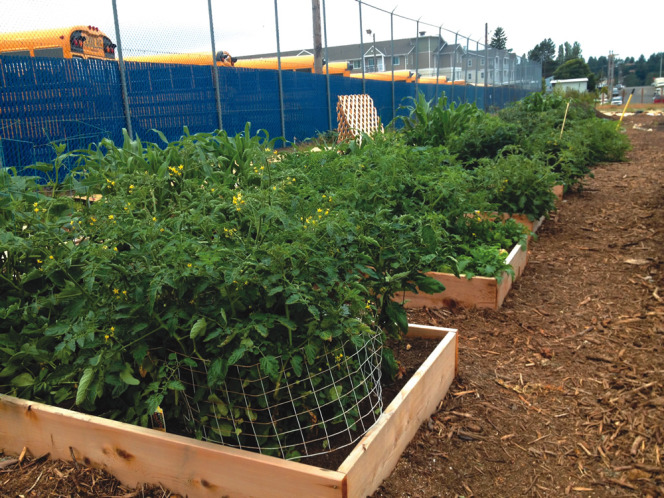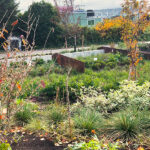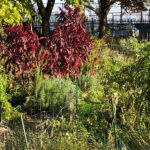
Sally Brown
BioCycle December 2014
There is no such thing as unleaded when talking about soils in urban areas. If a car had ever been driven near or paint had been applied to a home built on the soil prior to 1975, that soil will have measurable concentrations of lead. It can be detected in soils at the subparts per million range. Lead can cause developmental delays and reduced mental capacity. In short, lead is bad. But does a measurable level of lead in soil mean that you should be terrified to touch it? More importantly these days, does it mean you should be afraid to grow food in it?
This is a critical issue for organics recycling for a number of reasons. Much of the impetus for decentralized composting in urban areas comes from urban farmers who realize that compost is the key to soil health and successful gardening. In areas where centralized collection of feedstocks is the norm, these same growers are potential customers for finished products. Their potential to start composting and to use compost in their gardens and urban farms will also increase if a fear of lead contamination doesn’t stifle their efforts. That in part may depend on whether organics recyclers and healthy soil professionals can explain that using compost not only grows great vegetables, but serves to protect the consumers from any threat of lead contamination. To be a good explainer, some basics about the hazards associated with excess lead in soil must be well understood.

If concern remains about soil lead, suggest building a raised bed and filling it with compost or biosolids to ensure that the lead levels are low. Also cover bare soil in the walkways with grass or mulch to prevent exposure to soil or dust. Photo courtesy of Kristen McIvor, Pierce (WA) Conservation District
So what are the risks associated with elevated soil lead? The big concern is getting that lead in the stomach. The best/worst way to do that is to eat the lead contaminated soil directly. That may not sound too appetizing to readers of this column, but to a little kid it likely sounds a whole lot better than eating some kale. Children will also be less likely to wash their hands before eating — another way to accidentally consume some soil.
Lead Solubility
Getting soil lead into the stomach is not the whole story. Once in there, that lead has to become soluble and be absorbed by the body in order to pose a risk. Here again, it isn’t so simple. The potential for the lead to come into solution depends on two factors: how acidic the receiving stomach is and the form of lead in the soil. When a stomach has no food in it, it will be highly acidic. Hence that source of discomfort known as acid indigestion. Once some food is in there, the pH goes way up and the solubility of the lead goes way down.
The solubility of the lead can be changed by changing the mineral form of the lead. The same way that the properties of carbon change, based on the chemical structure, the properties of lead change according to what it is bonded to. Lead carbonates (cerrusite) are some of the most soluble forms of this element. Lead phosphate, in particular pyromorphite, is one of the least soluble forms. Once in their gut, the lead in children’s stomachs will be more efficiently absorbed into their systems than any lead in an adult stomach. So kids eating dirt are the primary risk associated with elevated soil lead. The risk assessment associated with lead in soil is all based on the potential for a little kid playing in the dirt on an empty stomach.
How about plant uptake? Here again, the main problem is associated with soil. Plants do not readily take up lead, however, many plants readily take up dirt. Here I am talking about plants like lettuces where some soil can adhere to the leaves and make for a crunchy salad. It is noted in the literature that carrots take up lead actually inside of the plant rather than just adhering to the surface. Lead concentrations in carrots, while higher than in other vegetables, are still in the low parts per million range. There has not been any research to look at how much of that lead will come into solution and be absorbed by the body when the carrot is eaten. Based on previous work with lead uptake in full versus empty stomachs, the answer is very, very little.
How much harm the lead does if anyone does eat the dirt or the carrot and lead is absorbed into their system depends also on how often people snack on soil. A one time exposure will not cause harm. Lead toxicity is chronic and not acute. That means that harm only results when soil and carrots are eaten frequently over time.
So to sum up, lead contamination of soils in urban areas is from historic sources. Old homes and old roads are where one would expect contamination to be highest. Areas near the homes (drip lines from the roof) and near the streets are likely to have the highest soil lead. The big concern is for little kids eating the soil, either on purpose or accidently. Dust is also a concern though not a focus here. Washing hands before eating and after playing in the dirt is a terrific idea.
Question Du Jour
Now let’s get back to the question at hand: Is it safe to grow food in soil that is potentially contaminated with lead? For the vast majority of gardeners, the answer is resoundingly yes. But if they look on the Internet, that is not likely the answer they will find.
When looking online for advice about gardening in lead contaminated soil, it is easy to find contradictory guidance. For example, the U.S. EPA’s guidance currently says that 400 ppm lead in soil is as high as one can go for a children’s play area, but that 1,200 ppm is fine if it is a nonplay area (EPA Soil lead level guidance). For people living in Michigan, the state’s guidance indicates that lead levels over 100 ppm are cause for concern and that if soil tests show over 400 it is time to call in a professional.
But whether one looks to EPA or to Detroit, there is one central piece of advice that all agree on — using compost or other soil amendments such as biosolids reduces any risks associated with elevated lead in soil (EPA Urban Garden Fact Sheet (pdf file)). These residuals-based soil amendments reduce any hazards associated with soil lead in two ways. The residuals will have much lower total lead concentrations than the soil. Mixing amendments into the soil will dilute the lead concentration. In addition, many of these amendments, particularly those with high concentrations of iron or phosphorus, will help to bind the lead. So if the lettuce is not washed enough and there are soil particles in the salad, the lead on the lettuce will be less likely to be absorbed than before the compost was added to the soil. Plus the plants will grow better, not just making it safer but producing more lettuce too.
Advice To Urban Farmers
So here is the advice that can be offered to urban farmers asking if they should or should not be concerned about lead in soil: Use compost to make your garden grow. It they are concerned, that is even more reason to use compost.
If those asking want to be sure the soil in their garden is okay, recommend they get the soil tested. Realize that there are two types of tests for lead. Total lead is not a routine test but those are the numbers that EPA is referencing in its guidance. Available lead is often measured using soil fertility extractions. Those numbers are likely what the Michigan extension link was referencing.
If those numbers are elevated, use a lot of compost and add some every year. (Note that what comes back as “elevated” depends on where the soil gets tested and what soil test is used. There is no absolute number for what constitutes elevated soil lead.) If the results are higher than the gardener or urban farmer feels comfortable with, suggest building a raised bed and filling it with a regulated soil amendment like compost or biosolids so they can be sure that the lead levels are low. In addition make sure to cover bare soil in the walkways of the garden with grass or mulch to prevent exposure to soil and dust.
The risks associated with elevated soil lead for urban agriculture are the same as the risks associated with elevated soil lead anywhere — accidental ingestion of soil. That risk is from eating dirt and not from eating vegetables. Eating those vegetables makes people healthier and not sicker. What is important is making sure no dirt is eaten in the process of growing the vegetables and that the vegetables are well washed before being consumed.
This should be enough information to ease the concerns of potential growers. It should also reinforce the importance of soil amendments for urban soils. From here the discussion can and should move on perhaps to favorite seed varieties or recipes for kale salads.
Sally Brown is a Research Associate Professor at the University of Washington in Seattle and a member of BioCycle’s Editorial Board.









